Monday, 3 October, Passau, Germany
Written 18 February 2023
Amazing what you learn on the Viking cruise . . . . In response to a question that came up at dinner yesterday, I looked it up, and the traight-line distance from Auckland, New Zealand, to Sydney, Australia, is 2211 km (1374 miles). Now you know.
During the night, we passed out of Austria and into Germany, mooring at today's stop—Passau (population ca. 50,000)—during breakfast. We also somehow passed from the summer's problem—too little water in the rivers—to a new one—too much water in the rivers, about which more below.
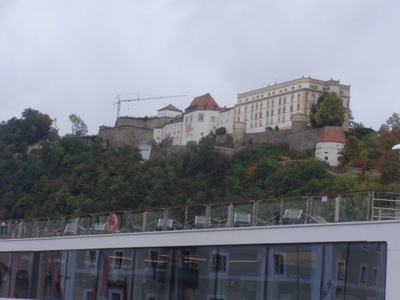
 Right after breakfast, we set off on our morning excursion, a walking tour of Passau (leisurely version), right from the ship—no bus involved. The photo at the left shows the Prince Bishop Elector's palace, which overlooks the town from the opposite bank of the Danube.
Right after breakfast, we set off on our morning excursion, a walking tour of Passau (leisurely version), right from the ship—no bus involved. The photo at the left shows the Prince Bishop Elector's palace, which overlooks the town from the opposite bank of the Danube.
The Prince Bishop Elector ruled the town for 1800 years. For most of that, Passau was the center of the largest diocese in Europe. The inhabitants were not happy with the arrangement. First, the poor people rebelled because the bishop was clearly living the high life off their taxes. Then the rich merchants rebelled because they wanted independence and more autonomy. But the bishop always won—he literally had the high ground. Throughout our day in the town, I tried to find out why the palace has "1999" painted on it in numerals so large it's clearly visible all over town, but I never got a satisfactory answer. Any readers out there know?
At the right is a handsome goose that happened to be hanging around the ship. And while waiting on the dock for our tour guide, Martina, to get organized, I also spotted a female common merganser.
Passau is at the confluence of three rivers the "blue" Danube, the pale green Inn from the Alps, and the dark brown/black Ilz from other mountains. You can actually see the three plumes where they come together. Filter-feeding freshwater mussels used to keep the Ilz water very clean, but they almost died out from overfishing, so they're protected now.
People have lived in a named village at this site for more than 2000 years—first the Celts, then the Romans, who were here until aabout 500 AD.
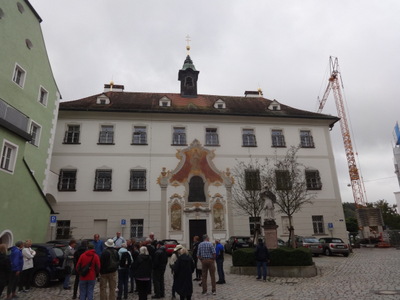
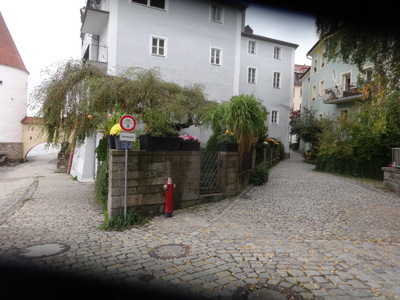 The building in the left-hand photo is an orphanage. It was given by an innkeeper in 1749 for the purpose of sheltering 24 24 children, 12 of each sex. The children had to be legitimate, and I think the guide said that both parents had to be christian. The children learned reading, writing, and a little counting, but they had to work, and they were required to say daily prayers for the founder. It's still in operation today, as a shelter for children of distressed families.
The building in the left-hand photo is an orphanage. It was given by an innkeeper in 1749 for the purpose of sheltering 24 24 children, 12 of each sex. The children had to be legitimate, and I think the guide said that both parents had to be christian. The children learned reading, writing, and a little counting, but they had to work, and they were required to say daily prayers for the founder. It's still in operation today, as a shelter for children of distressed families.
At the right is a particularly beautiful little garden we walked by. The size and carefully pruned shape of the weeping birch makes clear that it has been lovingly tended for a very long time.
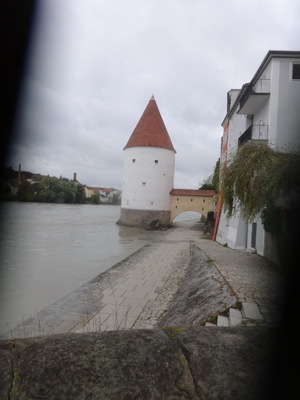
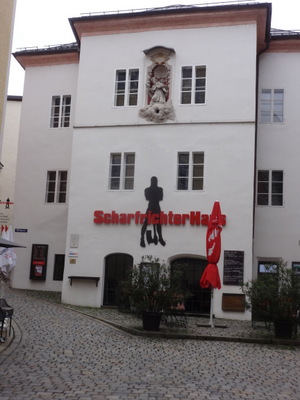 At the left here is a better view of the Schaibling Tower (visible at the left edge of the photo of the garden), which stands out in the river, joined to the shore by a little covered bridge. It's been there or 800 years and was part of the mechanism by which Passau maintained its monopoly on salt from Salzburg. All ships were required to stop at Passau, unload everything they carried into the town's warehouses, where it had to remain for three days while the town's merchants looked it over and bought whatever they wanted. Then the rest could be packed back aboard, and the ship was allowed to continue.
At the left here is a better view of the Schaibling Tower (visible at the left edge of the photo of the garden), which stands out in the river, joined to the shore by a little covered bridge. It's been there or 800 years and was part of the mechanism by which Passau maintained its monopoly on salt from Salzburg. All ships were required to stop at Passau, unload everything they carried into the town's warehouses, where it had to remain for three days while the town's merchants looked it over and bought whatever they wanted. Then the rest could be packed back aboard, and the ship was allowed to continue.
At the right is the Executioner's House, just around the corner from city hall. At some point in history, it apparently was the official residence of the executioner, but he never actually lived there. It's now a restaurant, comedy club, and independent art cinema. Some years back two young men formed a cabaret group called "The Two Executioners" (actually a splinter group from a larger group of "Executioners" in Munich; they wore black hoods on stage and everything) and set up shop here. Every year since 1984, a comedy competition has been held here. The prize is the Executioner's Axe, and many famous comedians have gotten their big break from winning it.
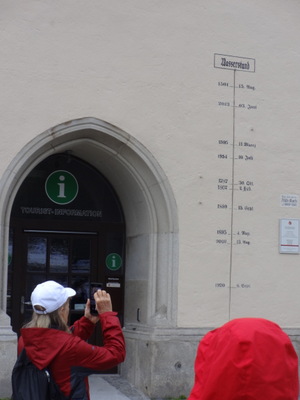
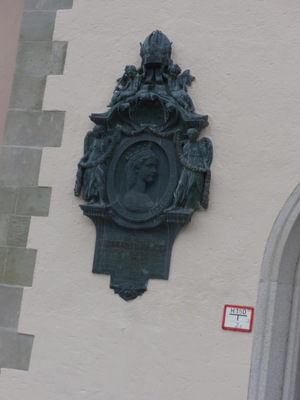 Just around the corner, in the town hall square, is the door to the tourist information office and its amazing flood gauge. The town has always been prone to floods (The Inn is actually wider than the Danube at this point, but it's officially the tributary because the Danube is deeper and overall a little longer). They are less of a problem now than the river is dammed and locked, but floods still happen. The all-time worst (the mark just below the sign at the top, which just says "water marks" was in 1501 AD. The second worst (the next mark below that, by 30 cm) was in 2013! Yikes! You can see the size of the door and the heads of the people standing around . . .
Just around the corner, in the town hall square, is the door to the tourist information office and its amazing flood gauge. The town has always been prone to floods (The Inn is actually wider than the Danube at this point, but it's officially the tributary because the Danube is deeper and overall a little longer). They are less of a problem now than the river is dammed and locked, but floods still happen. The all-time worst (the mark just below the sign at the top, which just says "water marks" was in 1501 AD. The second worst (the next mark below that, by 30 cm) was in 2013! Yikes! You can see the size of the door and the heads of the people standing around . . .
Near the tourist office was the plaque shown in the right-hand photo commemorating Empress Elizabeth (Sisi, remember her?). According to the guide, she and her husband (Franz Joseph I) were cousins; their mothers were sisters. She remained slim waisted despite four children but always kept her fan in front of her face because she had bad teeth. She allowed no photos after age 30.
Passau also has a very old university, founded in 1400. In 2013, 12,000 students came to help clean up after the flood. They were extremely well connected through the internet and knew exactly how to organize, who needed help, and where they should show up. About a year later, the walls were dry enough and people could start renovations. There was no flood insurance. The German government paid 80%. and the rest came out of resident's pockets; they had only three years to start renovation to get government money.
The Inn is now 3 to 4 feet above level; it started rising ovenight because of all the rain we've been getting. They've opened somedownstream locks to let some of the water down. As we walked along its bank in the course of the morning, we could see that it was beginning to lap over the embankment onto the sidewalk where we were. Walking from the Danube to the Inn and back was easy, as the part of town we were touring is on the low peninsula formed where the Inn joins the Danube at a sharp angle. The Ilz come in from the other side and joins the Danube just a few yards before the main confluence.
Written 19 February 2023
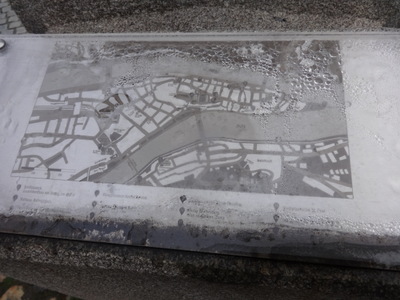
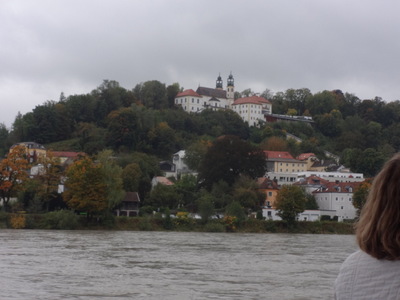 This map shows the configuration, with the Danube at the top, the Inn at the bottom, the peninsula in between, and the confluence of the Ilz mostly hidden by the big drops of condensation near the upper right corner.
This map shows the configuration, with the Danube at the top, the Inn at the bottom, the peninsula in between, and the confluence of the Ilz mostly hidden by the big drops of condensation near the upper right corner.
Across the Inn is this two-towered pilgrimage church, the Mariahilf. It's eached by a 321 step pilgrimage stair; it represents Jesus as God and Jesus as man, two aspects of the trinity (3 in 1), hence 321. Most of the area across the Inn is Austria, but a little of it belongs to Passau.
In 1974, Passau wnted to biult a new kindergarten over there, but in digging the foundations, they found the original Roman fortress. So they move the kindergarten elsewhere and now have their Roman on the site.
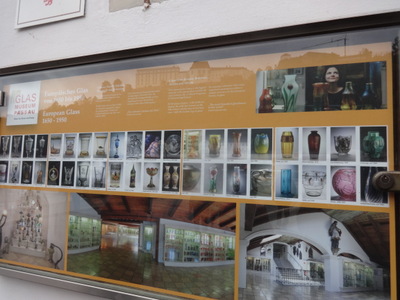
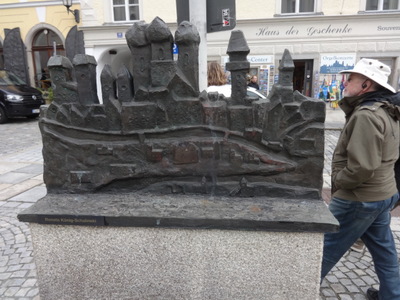 Our next stop was the lobby of the apparently quite famous Hotel Wilder Man, the Wild Man Hotel. It's old enough to have put up the crews of those salt boats that were stuck in town for the manditory three days, and the locals called them the wild men (as in, "Lock up your daughters, the wild men are in town!).
Our next stop was the lobby of the apparently quite famous Hotel Wilder Man, the Wild Man Hotel. It's old enough to have put up the crews of those salt boats that were stuck in town for the manditory three days, and the locals called them the wild men (as in, "Lock up your daughters, the wild men are in town!).
The hotel's famous guests include Sisi (see visited Passau three times and was a guest in the hotel twice), Henry Kissinger, and the Queen of Sweden. More interesting to my way of thinking is that the founder of the hotel collected art glass, so the hotel includes a glass museum. The photo at the left shows just part of the large bulletin board in the lobby advertising the museum. The collection includes 30,000 pieces (of which over 1000 are Loetz glasses, but only 15,000 are on display. Apaprently he had to buy up adjacent buildings and run tunnels to house it all. For the grand opening, he wanted to invite the most important person in the world; he chose Neil Armstrong.
Not content with just collecting things, he also formed Rotel Tours, a company that conducts tours in huge red buses that include "capsule" sleeping quarters! The business is still operating—just Google "Rotel Tours" to see photos of these amazing vehicles.
I think he also founded an open-air "Museum of the Forest" with about 150 buildings and graineries, fire stations, farmhouses, mills, schools, etc.
Right next to the hotel was Höllgasse, meaning muddy or dark alley, which is now a street of artists. It's marked by a winding line of painted paving stones, and art festivals are held there annually.
The photo at the right is of a handsome bronze map, mounted together with the map shown above. On the edge of its mounting is the artist's name: Renate König-Schalinski.
We frequently crossed paths with other tour groups, and our guide reminded us that they can have five or six Viking ships in town at a time, plus those of other companies, so the city needs a lot of tour guides—several for each Viking ship and for each of the others as She's having to turn down jobs because she just can't fit them into her schedule!
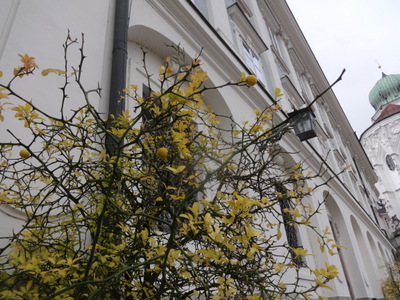
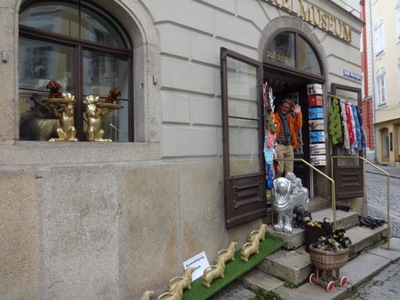 In front of the town hall (I think) was a row of these extremely spiny and almost leafless citrus trees. The guide said the small fruits were extremely sour but are used for cooking. She didn't know a name for them.
In front of the town hall (I think) was a row of these extremely spiny and almost leafless citrus trees. The guide said the small fruits were extremely sour but are used for cooking. She didn't know a name for them.
Nearby was the world's only dachshund museum, opened about four and a half years ago. The photo at the right shows a row of dull-golden dachshunds (actually plastic watering cans) marching up a green ramp (also labeled "dachshund entrance") to the door. On the window sill are two gilded dachshund end tables, each bearing a brown dachshund bobblehead. On the front step is a silver dachshund bench, topped by a silver dachshund planter. On the lower steps are black iron dachshund bootscrapers. The basket and bag hold many different dachshund plush toys. And in the doorway, flanked by a rack of dachshund-themed socks, another of dachshund scarves, and a wide variety of colorful dachshund-printed cocktail napkins, one of the owners waves to passing tour groups. Like many of these "museums" we've encountered, it's actually more of a dachshund shop, but its holdings are impressive nonetheless!
In a steep curving street we passed in our perigrinations are two high schools, one mixed and the other for girls. Both occupy former monasteries. An English nun named Mary Ward left England traveled all over Europe in the late 16th and early 17th centuries a nun, founding girls' schools. Manay are still in operation, including this one.
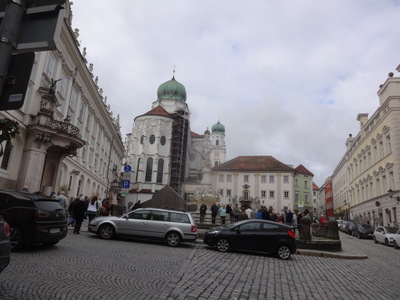
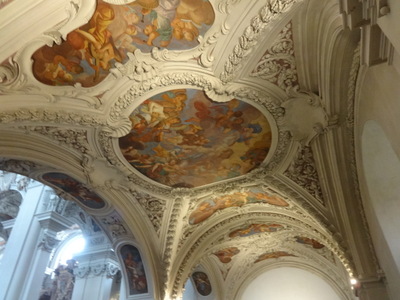 At the left here is our first view of the cathedral, with its green domes and vertical stack of scaffolding. I think the blue and white building to its left is the bishop's palace. It was built between 1000 and 1600, but a catastrophic fire in 1662 destroyed 80% of the town and most of the cathedral. Portions still stood, but they were weakened because the stones were cracked. Some months later, the salute guns fired on Corpus Christi Day brought more of them down. Fortunately no one was inside at the time.
At the left here is our first view of the cathedral, with its green domes and vertical stack of scaffolding. I think the blue and white building to its left is the bishop's palace. It was built between 1000 and 1600, but a catastrophic fire in 1662 destroyed 80% of the town and most of the cathedral. Portions still stood, but they were weakened because the stones were cracked. Some months later, the salute guns fired on Corpus Christi Day brought more of them down. Fortunately no one was inside at the time.
A few years later, they started to rebuild, but they couldn't do it with local talent. Between the fire and many years of fighting between Protestants and Catholics (Luther was popular in Passau; many Protestants were given the choice of reconversion to Catholicism, exile, or death), they didn't have the manpower. So they brought in Italian artists, heavily into Baroque, which explains why the church is such a mixture of Gothic and Baroque styles.
Again, groups cannot go in with guides, but we were able to go in and look around on our own while the guide waited outside. The photo at the right shows some of the frescoes in the ceiling.
The organ was once the largest in the world, at 17,974 pipes. It actually consists of a main organ and four smaller "side" organs stashed at various points around the building. The organist can play all five simultaneously or just one at a time. In the 1930s, the U.S. began to built two larger ones, but they are concert organs, so, the guide assured us, Passau still has the largest church organ in the world. Of course the organs at Los Angeles First Congregational and the chapel at West Point are also larger, but they're Lutheran.
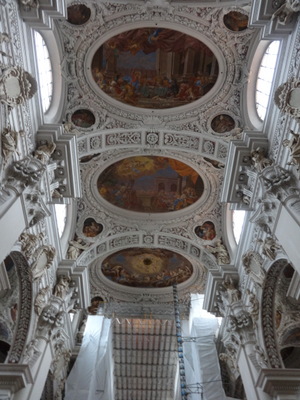
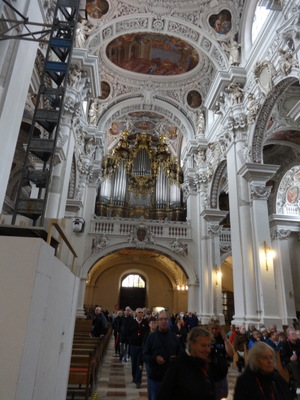 Here's another view of the ceiling (at the left) and the view back down the nave toward the main organ (at the right).
Here's another view of the ceiling (at the left) and the view back down the nave toward the main organ (at the right).
The altar is unusual. It dates only from the 1950s and represents the stoning of St. Stephen in 340 AD.
Several times during our visit to the city, we were told (with some pride) that the current bishop is the youngest bishop they've ever had, in fact the youngest in the entire Roman Catholic hierarchy at only 49, and that he's very good looking. (Probably important in getting at least the young female parishioners to attend church more faithfully.)
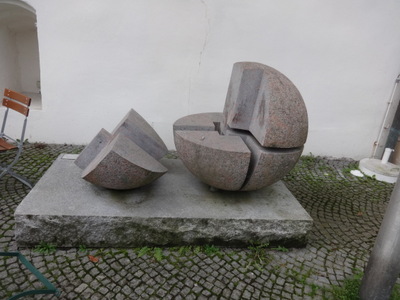
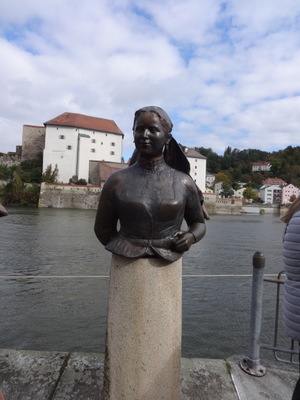 On the way back to the ship for lunch, we passed this handsome artwork showing a stone sphere that apparently comes apart like those interlocking wooden puzzle boxes. Surprisingly, I haven't be able to find out anything else about it—can't find the right Google search terms.
On the way back to the ship for lunch, we passed this handsome artwork showing a stone sphere that apparently comes apart like those interlocking wooden puzzle boxes. Surprisingly, I haven't be able to find out anything else about it—can't find the right Google search terms.
On the other hand, this bronze statue on the banks of the Danube is of Emerenz Meier (1874–1928), a local Passau writer and poet.
More stuff we learned in the course of our morning:
- Passau is a city of bishops. It got its first one in 700 and has had them continuously for 1300 years.
- When Passau was the largest diocese in Europe, it encompassed Passau and the whole Bavarian forest, Upper and Lower Austria including Voenna, and parts of Hungary.
- During a long peirod, Passau was an independent state, ruled by the Hapsburgs.
- The Cathedral here was the first St. Stephen's cathedral, before they became a dime a dozen.
- Budapest got its cathedal when it separated from the diocese of Passau. It was never actually part of the diocese, but there was some sort of connection. The bishop who named that one was trained here.
- The First christian King and Queen of Hungary were Stephen I and Gisela of Passau. When Gisela's husband and all her children died, she came back to Passau and entered the monastery and rose to became an abbess.
- The town hall is recognizable by the big clock on its tower. That's the civil office where you can get married. Above its door is a painting called the "beautiful woman of Passau."
Years ago, that whole area was the fish market.
- Fishing isn't allowed, but 12 men are "grandfathered in" and allowed to fish in the Ilz and another small stream; I think the right is heriditary. But the fish is clean enough to eat; there's a restaurant that serves Danube fish.
- A little white bus shuttle runs up the hill to the Prince Bishop's Palace every half hour from the town hall square.
- October 3, when we were in Passau, is Germany's national holiday, Reunification Day. November 9 was the day the Berlin wall actually fell, but it couldn't be designated a day of celebration because it's also the anniversary of Kristallnacht. As a result, many buildings were closed for the day, like the town hall. But because it's not a religious holiday, the cathedral was open.
- The Prince Bishop Elector's palace/fortress was was 800 years old in 2019 (there was a big celebration); ot too many bishops to build it, so why is 1999 painted on it. It's now the town's museum.
- Secularization got started around 1803. For example, science started to explain thunderstorms, so the bishops could no longer claim they were punishments from God. In 1951, the pope abolished all remaining prince biships in Germany (though I think there was one exception—some guy who was a bishop and happened also to be a prince in his own right).
- In Passau, it's very unusual to have a private apartment on the ground floor; instead artist's studios, parking, and restaurants occupy those spaces, with apartmens above.
- After power stations were built, the Inn lost most of its power and speed, but it's still faster than the Danube.
- When Pope Benedict retired, Passau went through 1-year interregnum before their new bishop was appointed.
- The coat of arms of the city on the town hall is a copy, because the original was damaged by acid rain and moved to a museum.
- "Schmuck" means jewelry.
- In 1803 Passau got the Wittelsbach Fountain, which bears three angels representing the three rivers. The angel facing the Inn is wearing a Tyrolean hat.
- On another fountain, the patron saint of Bavaria pointedly looks toward the town hall and not toward the church.
- The highest point of the town is about 60 ft above the rivers.
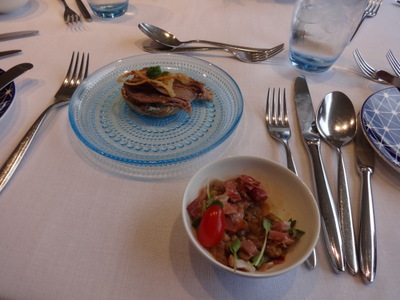
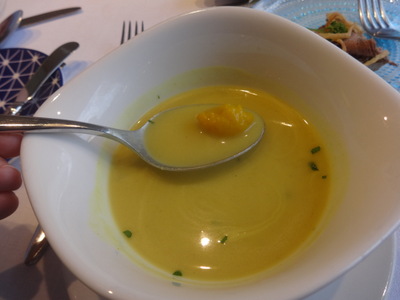 At the left here are the "fine print" appetizers: An open-face beef sandwich with crispy onions on top and a salad of lentils with diced prosciutto.
At the left here are the "fine print" appetizers: An open-face beef sandwich with crispy onions on top and a salad of lentils with diced prosciutto.
At the right is the curried cauliflower soup with little curried cauliflower florets in the bottom.
I apparently didn't photograph the main course, but looking at the choices on the menu, I'd bet I had the fish and chips. Undistinguished.
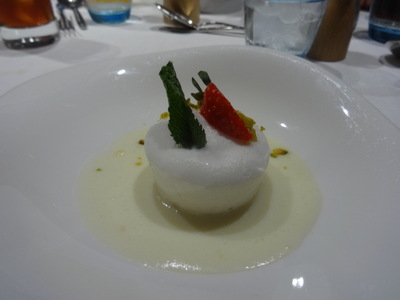
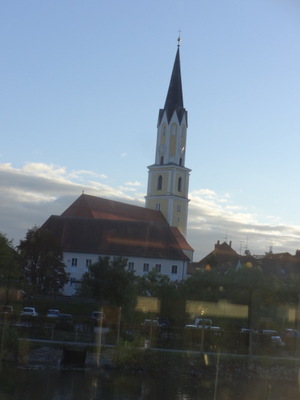 The dessert choices were floating island and chocolate chip sundae. At the left here is the floating island: soft meringue floating on a pool of boiled custard. It's traditionally drizzled with thick, clear caramel syrup, but here the chef just topped it with a strawberry wedge, a mint leaf, and a sprinkle of chopped pistachios. I prefer the caramel.
The dessert choices were floating island and chocolate chip sundae. At the left here is the floating island: soft meringue floating on a pool of boiled custard. It's traditionally drizzled with thick, clear caramel syrup, but here the chef just topped it with a strawberry wedge, a mint leaf, and a sprinkle of chopped pistachios. I prefer the caramel.
At the right is a random steeple we passed at dusk as we cruised toward our next stop: Regensburg.
During the afternoon, we were scheduled to board a barge for a side trip up the Inn to the baroque town of Schärding for an organ recital. But as has been mentioned above, the Inn was raging, and still rising, so the Viking crew announced that the excursion had been cancelled: deemed unsafe.
So about 2:30 pm, we sailed off up the Danube once more, toward our next destination: Regensburg. We even piked up a little time on the schedule, because the ship didn't have to stop at Vilshofen to pick us up after the barge tour. But maybe we lost it again when, about 45 min out from Passau, we stopped in the middle of the river for a whole, presumably waiting for ships to clear a narrow spot ahead of us. We noticed along the way that the the banks were a little more industrialized than they had been.
At the predinner briefing, tour director Marek outlined tomorrow's already rather complicated plans before revealing that the chances were about 50-50 that we wouldn't be able to get the ship under one of the bridges between Passau and Regensberg. We were due to get there ca. 2 am, and we'd find out in the morning whether we were able to get under it, whether we were downstream of it waiting for daylight before trying, or whether it was hopeless and we were stuck for a day until they could open the locks downstream to try to let some of the water drain away. At that point, there was a plan B involving very complicated logistics, which would be explained to us if necessary. All this time we'd been worried about low water only to find that high water was threatening (to mix a metaphor) to derail us!
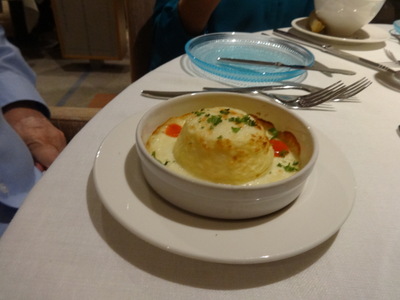
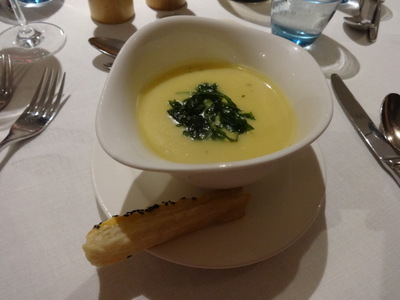 For dinner, David started with goat cheese soufflé, shown here at the left. He said it was more like goat cheese custard than a soufflé, but good anyway.
For dinner, David started with goat cheese soufflé, shown here at the left. He said it was more like goat cheese custard than a soufflé, but good anyway.
I had the Riesling wine, spinach, and cheese soup from the regional specialties menu. Also good. All of the many cream-style soups served on this cruise have been of uniformly high quality.
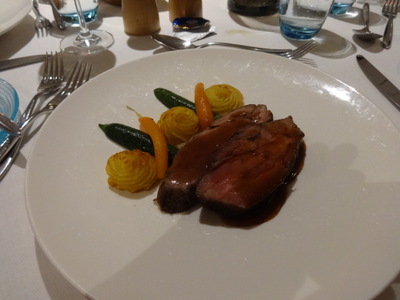
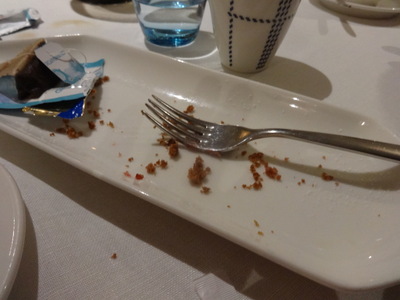 For the main course, we both had the scrumptious, boneless slow-cooked beef shortrib. Note the cute little "pommes duchesses"—puffs of mashed potato mixed with a little egg, piped into rosette shapes, and baked until toasty on top, a favorite preparation of mine.
For the main course, we both had the scrumptious, boneless slow-cooked beef shortrib. Note the cute little "pommes duchesses"—puffs of mashed potato mixed with a little egg, piped into rosette shapes, and baked until toasty on top, a favorite preparation of mine.
Dessert, from the regional specialties menu, was Linzertorte, oddly described on the menu as "spice cake with red currant jam." It's actually a rather thin tart of shortbread and jam (usually raspberry or apricot), named after the city of Linz. As you can see, I ate all but a few crumbs before remembering to take the photo.
Later in the evening, on the bow camera, I saw a cruise ship come past us, heading downstream. I hoped it was a good sign that they were able to get through.
Previous entry
List of Entries
Next entry

 Right after breakfast, we set off on our morning excursion, a walking tour of Passau (leisurely version), right from the ship—no bus involved. The photo at the left shows the Prince Bishop Elector's palace, which overlooks the town from the opposite bank of the Danube.
Right after breakfast, we set off on our morning excursion, a walking tour of Passau (leisurely version), right from the ship—no bus involved. The photo at the left shows the Prince Bishop Elector's palace, which overlooks the town from the opposite bank of the Danube.
 The building in the left-hand photo is an orphanage. It was given by an innkeeper in 1749 for the purpose of sheltering 24 24 children, 12 of each sex. The children had to be legitimate, and I think the guide said that both parents had to be christian. The children learned reading, writing, and a little counting, but they had to work, and they were required to say daily prayers for the founder. It's still in operation today, as a shelter for children of distressed families.
The building in the left-hand photo is an orphanage. It was given by an innkeeper in 1749 for the purpose of sheltering 24 24 children, 12 of each sex. The children had to be legitimate, and I think the guide said that both parents had to be christian. The children learned reading, writing, and a little counting, but they had to work, and they were required to say daily prayers for the founder. It's still in operation today, as a shelter for children of distressed families.
 At the left here is a better view of the Schaibling Tower (visible at the left edge of the photo of the garden), which stands out in the river, joined to the shore by a little covered bridge. It's been there or 800 years and was part of the mechanism by which Passau maintained its monopoly on salt from Salzburg. All ships were required to stop at Passau, unload everything they carried into the town's warehouses, where it had to remain for three days while the town's merchants looked it over and bought whatever they wanted. Then the rest could be packed back aboard, and the ship was allowed to continue.
At the left here is a better view of the Schaibling Tower (visible at the left edge of the photo of the garden), which stands out in the river, joined to the shore by a little covered bridge. It's been there or 800 years and was part of the mechanism by which Passau maintained its monopoly on salt from Salzburg. All ships were required to stop at Passau, unload everything they carried into the town's warehouses, where it had to remain for three days while the town's merchants looked it over and bought whatever they wanted. Then the rest could be packed back aboard, and the ship was allowed to continue.
 Just around the corner, in the town hall square, is the door to the tourist information office and its amazing flood gauge. The town has always been prone to floods (The Inn is actually wider than the Danube at this point, but it's officially the tributary because the Danube is deeper and overall a little longer). They are less of a problem now than the river is dammed and locked, but floods still happen. The all-time worst (the mark just below the sign at the top, which just says "water marks" was in 1501 AD. The second worst (the next mark below that, by 30 cm) was in 2013! Yikes! You can see the size of the door and the heads of the people standing around . . .
Just around the corner, in the town hall square, is the door to the tourist information office and its amazing flood gauge. The town has always been prone to floods (The Inn is actually wider than the Danube at this point, but it's officially the tributary because the Danube is deeper and overall a little longer). They are less of a problem now than the river is dammed and locked, but floods still happen. The all-time worst (the mark just below the sign at the top, which just says "water marks" was in 1501 AD. The second worst (the next mark below that, by 30 cm) was in 2013! Yikes! You can see the size of the door and the heads of the people standing around . . .
 This map shows the configuration, with the Danube at the top, the Inn at the bottom, the peninsula in between, and the confluence of the Ilz mostly hidden by the big drops of condensation near the upper right corner.
This map shows the configuration, with the Danube at the top, the Inn at the bottom, the peninsula in between, and the confluence of the Ilz mostly hidden by the big drops of condensation near the upper right corner.
 Our next stop was the lobby of the apparently quite famous Hotel Wilder Man, the Wild Man Hotel. It's old enough to have put up the crews of those salt boats that were stuck in town for the manditory three days, and the locals called them the wild men (as in, "Lock up your daughters, the wild men are in town!).
Our next stop was the lobby of the apparently quite famous Hotel Wilder Man, the Wild Man Hotel. It's old enough to have put up the crews of those salt boats that were stuck in town for the manditory three days, and the locals called them the wild men (as in, "Lock up your daughters, the wild men are in town!). 
 In front of the town hall (I think) was a row of these extremely spiny and almost leafless citrus trees. The guide said the small fruits were extremely sour but are used for cooking. She didn't know a name for them.
In front of the town hall (I think) was a row of these extremely spiny and almost leafless citrus trees. The guide said the small fruits were extremely sour but are used for cooking. She didn't know a name for them.
 At the left here is our first view of the cathedral, with its green domes and vertical stack of scaffolding. I think the blue and white building to its left is the bishop's palace. It was built between 1000 and 1600, but a catastrophic fire in 1662 destroyed 80% of the town and most of the cathedral. Portions still stood, but they were weakened because the stones were cracked. Some months later, the salute guns fired on Corpus Christi Day brought more of them down. Fortunately no one was inside at the time.
At the left here is our first view of the cathedral, with its green domes and vertical stack of scaffolding. I think the blue and white building to its left is the bishop's palace. It was built between 1000 and 1600, but a catastrophic fire in 1662 destroyed 80% of the town and most of the cathedral. Portions still stood, but they were weakened because the stones were cracked. Some months later, the salute guns fired on Corpus Christi Day brought more of them down. Fortunately no one was inside at the time.
 Here's another view of the ceiling (at the left) and the view back down the nave toward the main organ (at the right).
Here's another view of the ceiling (at the left) and the view back down the nave toward the main organ (at the right).
 On the way back to the ship for lunch, we passed this handsome artwork showing a stone sphere that apparently comes apart like those interlocking wooden puzzle boxes. Surprisingly, I haven't be able to find out anything else about it—can't find the right Google search terms.
On the way back to the ship for lunch, we passed this handsome artwork showing a stone sphere that apparently comes apart like those interlocking wooden puzzle boxes. Surprisingly, I haven't be able to find out anything else about it—can't find the right Google search terms.
 At the left here are the "fine print" appetizers: An open-face beef sandwich with crispy onions on top and a salad of lentils with diced prosciutto.
At the left here are the "fine print" appetizers: An open-face beef sandwich with crispy onions on top and a salad of lentils with diced prosciutto.
 The dessert choices were floating island and chocolate chip sundae. At the left here is the floating island: soft meringue floating on a pool of boiled custard. It's traditionally drizzled with thick, clear caramel syrup, but here the chef just topped it with a strawberry wedge, a mint leaf, and a sprinkle of chopped pistachios. I prefer the caramel.
The dessert choices were floating island and chocolate chip sundae. At the left here is the floating island: soft meringue floating on a pool of boiled custard. It's traditionally drizzled with thick, clear caramel syrup, but here the chef just topped it with a strawberry wedge, a mint leaf, and a sprinkle of chopped pistachios. I prefer the caramel.
 For dinner, David started with goat cheese soufflé, shown here at the left. He said it was more like goat cheese custard than a soufflé, but good anyway.
For dinner, David started with goat cheese soufflé, shown here at the left. He said it was more like goat cheese custard than a soufflé, but good anyway.
 For the main course, we both had the scrumptious, boneless slow-cooked beef shortrib. Note the cute little "pommes duchesses"—puffs of mashed potato mixed with a little egg, piped into rosette shapes, and baked until toasty on top, a favorite preparation of mine.
For the main course, we both had the scrumptious, boneless slow-cooked beef shortrib. Note the cute little "pommes duchesses"—puffs of mashed potato mixed with a little egg, piped into rosette shapes, and baked until toasty on top, a favorite preparation of mine.